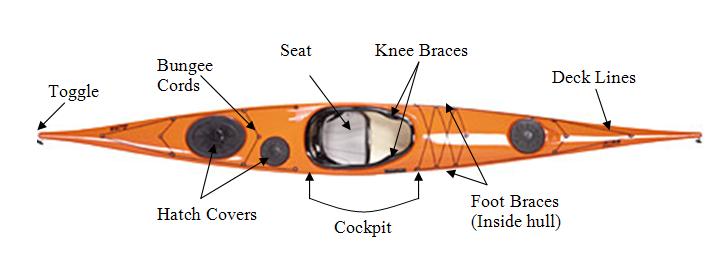If you’ve ever been interested in examining where my kayaking mind was about 7 years ago this may be your best chance! Today, while deep-sixing some of my old college notes, I came across this very interesting essay on “ocean kayaks” which I apparently wrote as an assignment in a Technical Communications course. I’ve found this blast-from-the-past to be fascinating because a) it’s probably the first piece that I ever wrote about kayaks and b) it shows how much I’ve grown as an instructor over the years.
Although I’m still content with many of the views presented in this essay I must say that my attitude toward kayak selection (especially with respect to material) and my understanding of everything to do with rudders and skegs has changed drastically with experience and is more appropriately presented in my newer “Choosing a Kayak” series. Enjoy the reading but just remember that if you have any gripes with the content you’re going to need a time machine in order to take it up with the Kayak Dave of yesteryear 🙂
-Kayak Dave
Ocean Kayaks
Ocean kayaks are one of the earliest forms of paddle craft known in the history of ocean travel. The Inuit tribes of Alaska and the Greenlanders were the first groups to develop kayaks as craft for traveling across bodies of water and for hunting whales and seals. Ocean kayaks remained a rare sight for the general public until the late 1970s when affordable, roto-molded (a plastic molding technique) kayaks were introduced. This led to a kayaking revolution in which recreational paddling became a popular leisure and exercise activity. In the present, thousands of styles of ocean kayaks are produced worldwide. Spotting them on car tops and waterways has become a daily occurrence.
Although there are many distinct styles available, all ocean kayaks contain the same basic structure and parts. All ocean kayaks are much longer than they are wide. The length ranges from 13-22 feet while the width ranges from 18-25 inches. The basic structure of an ocean kayak consists of a hull (bottom section that touches the water) and a deck (top section). The deck contains most of the standard features of ocean kayaks which include: deck lines (for safety), toggles (carrying handles), bungee cords (for securing equipment), and hatch covers (See Figure 1). The defining feature of ocean
Figure 1 – Standard Parts of an Ocean Kayak
kayaks, and all kayaks in general, is the cockpit. The cockpit is the place where the paddler sits with their head, arms and torso exposed and their legs confined within the kayak. The cockpit contains three important parts that define the three points of contact that the paddler makes with the vessel. The paddler sits down in a seat. They then pin their knees up against knee braces (foam pads) that are found just forward of the opening of the cockpit. The feet of the paddler come to rest on a pair of adjustable foot-braces. These foot braces are adjusted so that the paddler creates a diamond shape with their legs so that their knees are pinned comfortably against the knee braces. Ocean kayaks are designed to be an extension of the paddler. Proper adjustment is crucial as you should wear an ocean kayak, not simply sit in one.
The general rule is that the longer an ocean kayak is, the better it tracks (travels in a straight line in wind and current). Ocean kayaks that are closer to 13 feet in length have trouble tracking straight. To compensate for this, shorter length ocean kayaks come with one of two special features that help them to track better. The first feature is a rudder. The paddler is able to deploy the rudder with a cord and is able to turn the rudder by pushing on the foot braces. The second option is a feature called a drop skeg. The skeg is a fin that is attached underneath the kayak near the back of the hull. The skeg is usually hidden within the hull of the kayak but can be pulled down if the conditions become rough (See Figure 2). The advantage of the skeg is that there are fewer moving parts to take care of
Figure 2 – Comparison between Rudders and Skegs
compared to the more complicated rudder system. This makes the skeg more reliable. Using a rudder can turn into a bad habit for inexperienced paddlers. Beginners tend to use the rudder to turn the boat when its purpose is to keep the boat going straight. This is a bad idea because the rudder is designed to be there for when the conditions get rough. Proper paddling technique should be achieved before a beginner should invest in a rudder.
The last major feature that distinguishes ocean kayaks is the material that they are made of. There are four main types of materials that kayaks are made of. The first, and most popular material, is roto-molded plastic. Plastic is the most durable, heaviest and least expensive material that ocean kayaks are made of. The next most common material is fiberglass. Fiberglass is lighter than plastic. It is also less durable and more expensive. A third material that kayaks are made of is a carbon-Kevlar lay-up. This simply means that carbon and Kevlar fabric is used in the fiber glassing process in the place of the traditional glass fabric. Carbon-Kevlar is lighter that fiberglass, more durable, and much more expensive. The most exotic material that kayaks are made of is called “skin.” Skin can either mean a waxy paper or actual seal skin stretched over a wooden frame. The wax-paper skin boats are more popular, but the Inuit tribes still use seal skin. The skin boats are the lightest of all ocean kayaks. They are decidedly the least durable and are only a little less expensive than the carbon-Kevlar kayaks. See Table 1 for a comparison between the different materials (1 indicates “most” or “highest” while 4 indicates “least”
Table 1 – Comparison between Ocean Kayak Materials
|
Material Type |
Relative Durability |
Weight |
Cost |
| Roto-molded Plastic |
1 |
1 |
4 |
| Fiberglass |
3 |
2 |
3 |
| Carbon-Kevlar |
2 |
3 |
1 |
| Skin |
4 |
4 |
2 |
or “lowest” for the given category). In most cases, beginner level paddlers who are looking to buy their first ocean kayak are instructed to purchase a plastic model because they are the most durable. When the paddler becomes more proficient with their technique, it is then time to upgrade to a lighter, more aesthetic material.




